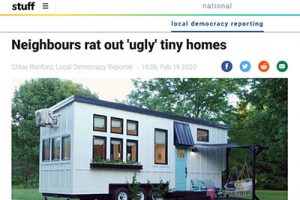LEARN MORE
shelter not buildings
Mobile homes are:
○ not buildings under the Building Act
○ not structures under the RMA
○ not real estate under the Land Transfer Act
They are mobile, not fixed to land.
They do not commit land; not in but on land, They serve immediate needs.
Made in a factory in a month, installed onsite in a day, they cost about a tenth of what KiwiBuild calls affordable housing.
Affordable, warm, dry, durable and attractive, they are another part of the solution for today’s housing needs.

Quick Read
For two decades the invisible industry making mobile homes for hidden homeless worked because there was no red tape.
To be clear, factory-made mobile homes are not DIY tiny homes. MHA speaks for factories not DIY.
Made in a factory in a month, installed on a site in an hour. $60,000 or $250/week, when the need passes, the mobile home is moved to the next site in a day.
No entangling, unaffordable costs for building consents or resource consents. Mobile homes have never been buildings (structures fixed to land) under the Building Act or structures (buildings fixed to land) under the RMA. They do not require subdivision of land, but instead are placed using a temporal right to occupy – a contract, not a deed or title.
Mobile homes do not commit land.
The land is not subdivided – no turning a $1 million paddock into 100 quarter acre sections selling for $100,000 each A hundred mobile homes can be installed on 10 hectares of prime ag land, be occupied for ten years in reverse land-banking. When no longer needed, the land reverts to paddock.
NZ grows 80 grams per m² of dairy solids; poor use of good farmland. Contrast this with 4,000 g/m² yield of market gardening. When the planet will need more food, NZ will up its game. That is when the mobile homes are towed away from the paddock. All that remains is prime topsoil, built-in irrigation standpipes and power to run advanced robotic farming that will become common by 2035.
Read this report
Mobile homes are unlike buildings.
The units must endure the equivalent of a combined 4-hour earthquake and tsunami before handing the key to the first owner. Try that with a building.
Councils are not set up to inspect factory-made products and their role is not appropriate. Building inspectors are necessary to ensure a dozen independent contractors all must do their own job right on a complex job. Also, LBP’s are not trained or qualified to manufacture factory-made mobile homes, LBP’s add unnecessary cost.
A system designed for complex, large structures, bespoke-constructed on site makes no sense applied to a single company fully responsible for the product that manufactures the same product over and over again in a factory. Use of councils is a waste of money and a waste of time.
The answer is to define them as what they are: mobile homes, not buildings.
Write fit for purpose regulations. Most importantly, in addition to safe, healthy and durable, mobile homes must be affordable. This means vernacular compliance not enriching BRANZ or funding councils.
Bottom line: No mobile home should incur more than $500 in fees, contributions or other council-required paperwork. Today it is $0.
No mobile home application should take more than 5 days for council paperwork. Today it is zero days.
Any rules that add cost or time mean fewer hidden homeless will be housed.
The government should be part of the solution not the problem.
UNDERSTANDING THE ISSUES AND THE SOLUTIONS

Ministries
The Ministries are divided. 2019 saw MBIE, MFE & NZTA officials go to war with tiny homes; determined to reclassify them as buildings to give council planners and BCA’s lawful control. MSD, HNZ and MBIE Civil Defence desperately need factory-made mobile homes (not the same as DIY tiny homes) that have become collateral damage in the tiny home war. MSD and HNZ acquired mobile trailer homes on trial in 2018-19, trials that were successful, but have held off on ordering hundreds of units due to the uncertainty created by MBIE.
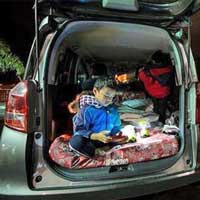
Hidden Homeless
Building Minister Jenny Salesa speaks about the hidden homeless in her Beehive Bio. 41,000 known to be sleeping in cars, tents, garages & overcrowded conditions. The number would be closer to 75,000 were it not for an invisible industry making mobile homes over the past two decades. Hidden in back blocks, behind trees & in marginal communities where neighbours do not complain to council, these most vulnerable New Zealanders have been leasing warm, dry, affordable homes; left alone by councils until 2019.
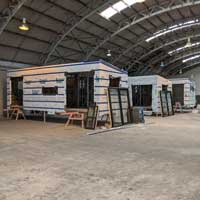
Mobile Homes
For two decades mobile home factories have manufactured efficient, affordable housing for NZ’s most vulnerable. Priced around $60,000 or $250/week lease they provide 1-2 bed, kitchen, bath & lounge in a warm, dry, safe mobile home. Most importantly, for two decades these units have remained immediately acquirable because they are not classed as buildings (Building Act) or structures (RMA). When need arises, a client places an order and within a month they move in. No council entanglement, cost or delay. Until 2019.
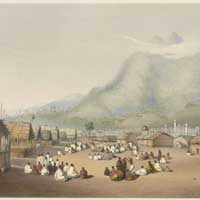
WE can fix it
NZ has an ancient development pattern relevant for the affordable housing crisis in 2020. Prior to colonisation, Māori balanced public and private life requiring smaller family homes (wharepuni) by creating real community with shared public space. This kainga model can be adapted for 2020 using affordable mobile homes for families in a car-free 24/7 “pop up kainga village” that provides both affordable housing and a supportive community for a 15-year period to allow the state to catch up. MHA
members can fix it. Just give them the “go”.
What are the official issues? What are the real issues?
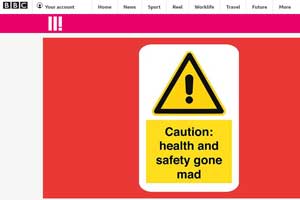
MBIE WRITES
MBIE wrote: “MBIE’s view is not that these dwellings are not allowed, but rather that those that are buildings for the purposes of the Building Act must comply with the requirements of the Building Act and Building Code.
Similarly, owners and manufacturers of such dwellings are expected to follow the relevant regulatory
processes, which exist to ensure the safety and wellbeing of building users.” Really?
LET’S BE HONEST HERE – IT’S ABOUT CLASS
Are MBIE or MFE or councils or the neighbours really concerned for the health and safety of the occupants? Let’s be honest here. This is a culture clash. Factory-made mobile homes are not ugly, and they blend in with their surroundings. Some DIY tiny homes do as well. But not all. Some DIY tiny home makers select “nice” neighbourhoods where they place units that annoy grumpy neighbours who complain to council.
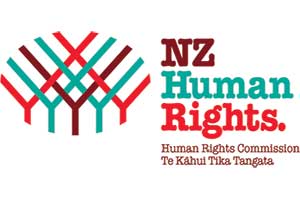
THE NZ HUMAN RIGHTS COMMISSION SAYS:
“The human right to adequate housing is a binding legal obligation of the State of New Zealand: the government has a duty to protect the right of people to enjoy adequate housing and it has a responsibility to provide remedies”
But when an affordable, immediate, safe, warm, dry solution is available, why is it that the State of New Zealand stands in the way?
OUR PROPOSAL
MBIE, MFE, NZTA and the councils must stop the obstruction. This means understanding the difference between a tiny home fixed to ground (it’s a building) and a DIY tiny home on wheels (it’s not our problem, sort it with NZ Tiny Home Association) and a factory-made mobile home not fixed to land. It’s not a building under the Building Act, not a structure under the RMA and not land (includes buildings and structures) under the Land Transfer Act. MHA’s focus is on factory-made mobile homes, not DIY tiny homes.
MHA members make factory-built mobile homes and have been doing so for two decades. MHA would prefer to turn the clock back to 2018 where the industry was invisible and its clients left alone, but MHA accepts NZ has become a rule-writing nation. Thus, let’s make sure the rule-writers understand MHA-member factory-made products are different than buildings and need fit-for-purpose rules, not trying to pound a round peg into a square hole.
01
Best approach is scaled
The most effective power of government is not regulation (saying no) but the power of permission (saying yes). MHA proposes that the status quo is accepted by MBIE, MFE, NZTA and councils – that mobile homes are not buildings, not structures and do not have a permanent effect on land. In other words, let them be manufactured and placed on site now. Then, in parallel, thought a national agency (probably Kainga Ora), negotiate a voluntary code of practice that sets out the typology certificate for each approved mobile home design. This is set out in a contract in which it is agreed no abatement notices or notices to fix are issued by council for units that have a valid certificate. Each unit has an exterior plate with a QR code that enables a council officer to confirm the unit is approved (and is not a building) and a GPS tracker that displays the location of all units nationwide.
02
Priority: Hidden Homeless over Cost Recovery.
Councils say they are concerned about health, safety and durability. The industry makes healthy, safe and durable units, so what’s the problem? Off the record, it is said councils are focused on cost-recovery… consent fees, contributions and rates. The problem is the cost and delays of consents. It can cost $30,000 to get approval for a $60,000 mobile home, and council takes months to approve. If it is about healthy & safety, then have central government set the total consent fees at $150 and the maximum allowable time for approval at 15 working days. If the consents are not granted in that time frame, they are approved by default. Let’s be clear. In Auckland Council, the general rate lost revenue from a $60,000 unit is $112. That means 1,000 hidden homeless means a lost-cost recovery of $112,000 a year. For a compassionate council, that is a bargain. The bottom one percent of the nation should not be squeezed to pay salaries of planners and BCA’s in council. It keeps them hidden homeless.
03
Build Kainga Villages Now
Shifting from the negative and the administrivia, begin to solve the hidden homeless and affordable housing crisis now. The lowest hanging fruit are kainga villages. Select land not vulnerable to NIMBY complaints (old campgrounds are the most likely), designate for 15-year kainga pop-up villages. No earthworks, no subdivision, no foundations. Units on 15-year right-to-occupy contracts. Design as real social housing with on-site public infrastructure that enables real social, economic and cultural wellbeing. Use this as an interim 15-year measure to allow central government and district plans to catch up. (Read More)
04
Skunkworks
As SHA and KiwiBuild discovered, the system will kill housing innovation because the structure of the system is flawed. Local councils must carry the infrastructure liability of new development but the increased revenue (income tax and GST) is not shared with them. Therefore, they have no incentive to cooperate. Likewise, for the private sector, the profit margins in social housing does not merit the risk; better to serve the comfortable class. The answer is to not play in that arena. Instead emulate a management system developed by Lockheed in World War II called Skunk Works. This is a lean public-private partnership in which the government has a rapid-approval system and the private sector is tapped for what they already do well. As it happens, government has introduced such a national group to manage this: Kainga Ora. It is recommended a PPP be established in which Kainga Ora identify suitable sites around NZ for pop-up kainga villages. This can be accomplished in months because the land is there, the factories are manufacturing homes, no subdivision or title change is involved, the units are not buildings under the Building Act and not structures under the RMA. “Together, we can do this”… now.
The bottom line is simple:
- Add no rule that increase cost to the hidden homeless. Cost should be limited to materials, labour & fair margin.
- Add no rule that delays access by the hidden homeless. Speed should mean as soon as it’s made, the client moves in.
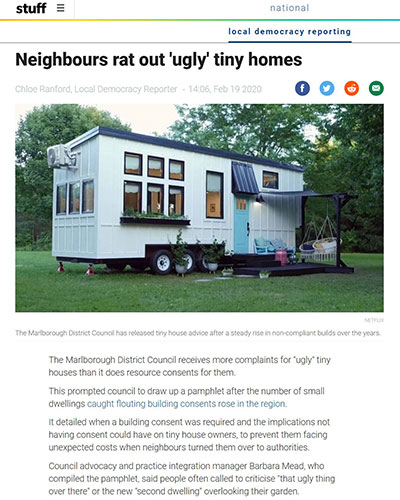

The Culture Conflict
What is the problem with “ugly” tiny homes?
Google Street-view shows the background of the conflict that became MBIE Determination 2019/017. Dall was dobbed in by a neighbour. The council had to find a violation to charge Dall, saying it was a building under the Building Act. In 2018, the council issued a Notice to Fix. In 2020 the Court set it aside. However, the photo is instructive. It is unlikely either the council or the neighbour cared about Dall’s health & safety. It was a cultural conflict. As the Stuff article describes, it’s ratting out ‘ugly’.
Unlike mobile home users, the tiny home movement has enthusiasts who place their units in “nice” neighbourhoods who complain to council. It is this aesthetic that drives the complaints that eventually get to MBIE, MFE and NZTA who then set about trying to write rules to make it hard.
The mobile home industry is sensitive to the importance of design and visual amenity. It is not size that makes the difference, it is colour, cladding, size/placement of windows & doors, and landscaping.
The industry searches the world for better materials and designs to find attractive, durable, safe materials that cost less to buy, less to install and age well. But it can’t do this if it is using its R&D funds to fight officials.
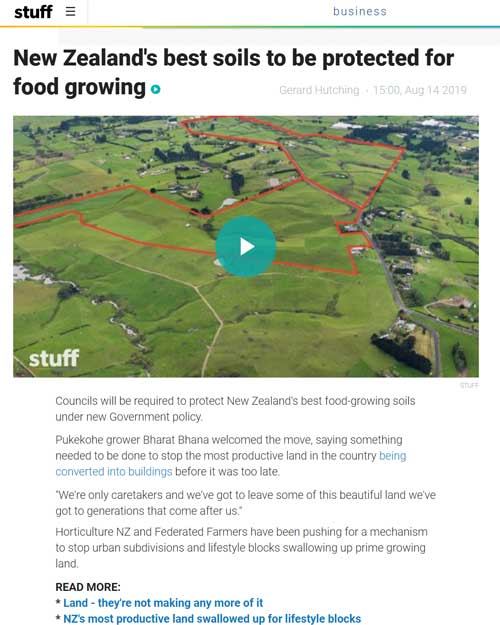

RMA: Reverse Land Banking
Preserve farmland for the future as kainga today.
A kainga is a temporary land use. The mobile homes are towed to site, installed in a day. Marquees are set up without foundations. The carpark at the entrance is permeable fabric laid on topsoil and covered with crushed stone. The kainga is intended to stand for 15 years.
In 2036, the right to occupy is withdrawn, mobile homes are towed away, marquees taken down and carpark lifted. All that remains is bare topsoil and standpipes that provide farm irrigation & power for hi-tech farming.
This means the NPS for Highly Productive Land should consider kainga to be in complete alignment with government policy. Read this reportfor facts.
Mobile homes land bank. They put the land on hold until needed for high-quality farmland. Meanwhile it enables people to provide for social & economic wellbeing.
Presuming global population grows as projected, the poor agricultural uses that are endemic in NZ will no longer be tolerated by future generations. Reverse land banking preserves farmland until it is needed.
Stop the Obstruction
Starting in 2019 local and central government began a campaign of obstruction that has wreaked havoc on the mobile home industry. It was not intentional, it was collateral damage. The target was the Tiny Home Movement where eco-warriors began to promote small living as a way to save the planet. Unlike the almost-invisible mobile home industry, the Tiny Home movement used social media and even reality TV shows to promote tiny homes. Not everyone was impressed, especially the neighbours in “nice” areas where the media reports “Neighbours rat out ‘ugly’ tiny homes“. Neighbours complained to councils, councils complained to their trade association. The trade association lobbied government officials. The campaign of obstruction began.
MBIE was on the attack using determinations. The test case was Determination 2019/017 where, as MBIE describes it, they “moved the dial“. This is a euphemism for violating stare decisis, the legal doctrine that obligates judicial process to follow historical cases when making a ruling on a similar case. Known as the Dall case, it was catastrophic in the mobile home industry. Waiting lists dried up. Order books collapsed. Production cut back. Investors who pay for the WINZ and MSD rental-book units became spooked. The tens of thousands of existing inhabitants of mobile homes became terrified that at any time a council officer would knock on their door and return them to the ranks of hidden homeless. Dall appealed the determination and on 19 February 2020, MBIE was soundly rebuked by Judge Callahan in Christchurch District Court. (read here).
House Hidden Homeless
For two decades, an invisible industry has housed the what Minister Jenny Salesa calls the hidden homeless. She describes them as “entire families living in tents, cars, garages or in severely overcrowded conditions, with two to three families sharing one house.”
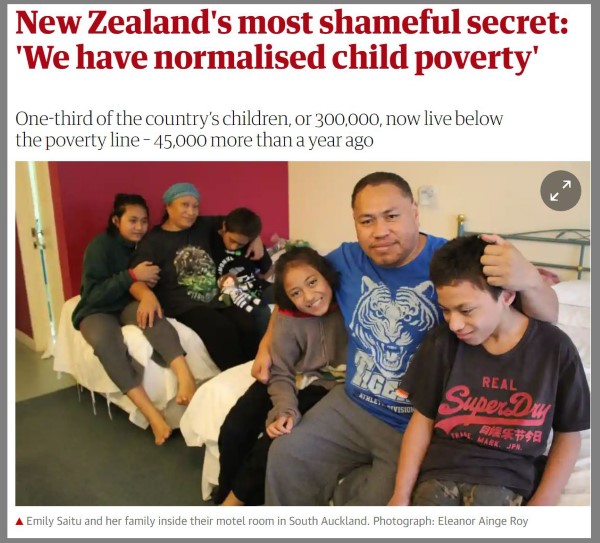
Reports say that 1% of NZ population, about 41,000 people are hidden homeless. Had the invisible industry manufacturing mobile homes over the past two decades not been housing the hidden homeless, it is likely that statistic would be 1.5% of NZ. Tens of thousands of mobile homes can be found throughout NZ, although they are not that easy to count.
Unlike the Tiny Home advocates who publicise their tiny homes on wheels, hidden homeless shun publicity. They don’t call attention to themselves. Their mobile homes are found on back blocks, behind trees, or in neighbourhoods where neighbours don’t complain to council.
Since the coalition government took power, the statistics have grown worse. 14,500 on the state housing waiting list. $100 million spent in nine months on hotel rooms in which entire families are housed – far from where their children went to school. And the 41,000 hidden homeless number is someone’s estimate. It probably does not include the six uni students sharing a one-bedroom flat, couch surfing, or the 30 cars on Waiheke with hospitality workers who pay $100 / week to sleep undisturbed in their car, using the single-family dwelling for showers.
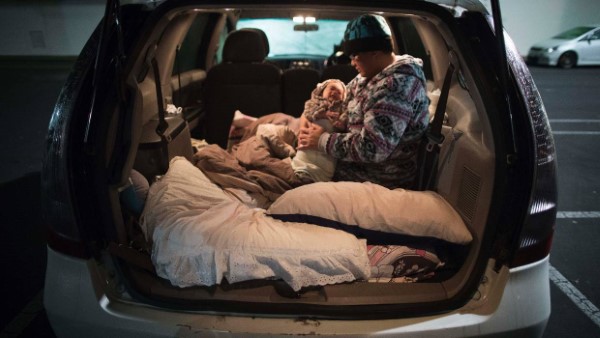
The mobile home industry has an interim solution. At present, before the obstruction, the hidden homeless would hear about the mobile home solution, find someone with land (usually with an arrangement similar to Maori tuku – a right to occupy out of kindness rather than a formal leasehold), qualify for rent, rent to own, or financing, and place an order. A month later, at a cost of $500 for delivery, the new home – one-two bed, kitchen & bath, lounge and deck – would be delivered and set up in a day. $60,000 or $250/week lease. Had that mobile home been classed as a building, additional fees and charges increase the price by $30,000, making it unaffordable by the hidden homeless.
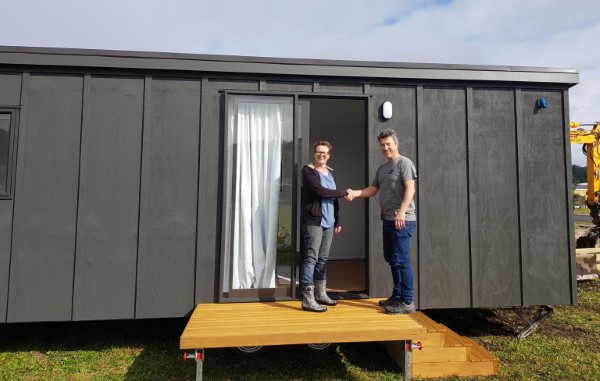
TWO PROPOSED LEVELS OF GOVERNMENT ACTION
Kainga: Prior to colonisation, Aotearoa had a very successful development pattern known as the kainga. Unlike today’s Maori settlements with European style housing along streets and somewhere in the community a marae with a whare nui and whare kai, the kainga was an integrated village with a very careful balance of public and private space.

The kainga would be comprised of the familiar commons buildings, but also have dozens or even hundreds of wharepuni: small private family homes where people slept. This is very different than the terraced state housing lined up where the only public space is the street.
Kainga is a model for all, not just Maori. It involves selecting a reasonably large piece of land – Crown, council, iwi or private – that is not subdivided. Instead the wharepuni (mobile trailer homes) are granted a right-to-occupy. Cars are parked outside the urban core, making the internal area safe for all. As a transitional pop-up village, a 12m diameter marquee is erected with a BBQ and picnic tables. A second marquee is stocked with tools to enable the people to make things to use and to sell. A third marquee is put up that has benches – a place to meet.
All that is required is appropriate land (preferably flat) and access to potable water, wastewater treatment system and power – all of which can be self-contained. If the approach used powers similar to wartime powers, land could be prepared in a month with standpipes to each mobile home parking site. In that same month, the mobile homes can be made in the factories. With assurance of a regular flow of contracts, the ten or so manufacturers in NZ each estimate they could make 40 units a month. That is 400 families per month taken off the hidden-homeless roles. And if Kainga Ora became involved and made it a matter of national interest, production of 10,000 in a year is feasible.
This is not proposed as a permanent solution, but an interim one. A KiwiBuild home cost $500-650,000. These units cost a tenth of that and go up in a tenth of the time. For now, make them a 15-year interim.
Infill: Most of the mobile housing supplied over the past two decades has been infill or a single unit installed on a single section.
From an RMA perspective, it is no different than an additional bedroom or two being added. Effects can be assessed to ensure it is suitable for the land, but the rigid interpretations put forth by certain councils must be addressed by superior authority.
Some plans say a caravan is a building and by extension a mobile trailer home requires a resource consent as a second dwelling on a property. This can add cost. Indeed one community housing trust in NZ has spent well over $60,000 of donor money and three years trying to secure consent for a reasonable proposal to house a few hidden homeless. This is an abuse of the purposes of the RMA.
CIVIL DEFENCE TOURISM

In 2019, another part of MBIE purchased ten mobile homes and it granted itself an exemption from the Building Act. Aside from the double-standard this exhibited, it is something MBIE should be considering at a much larger scale.
26 MARCH 2020: With Covid-19, NZ’s hidden homeless may rise from the current 1% of NZ population to 3-5%. People will fall through the cracks.
Note that the Visitor Industry Infrastructure comment that was in this place on this web page has been moved below and lined out. It is likely that Covid-19 has destroyed NZ’s tourism industry for the foreseeable future.
In the event the Alpine Fault or the Hikurangi Subduction Zone breaks, it is likely thousands of homes will be destroyed in a matter of minutes. The lessons learned in Christchurch show that while people can be temporarily housed in shelters, within a few days, they need to get back into a home and begin to pick up the pieces. In some cases (like in the Jonas Voss litigation), they need a temporary home on their property either for themselves or their repair people. However, while thousands of units may be needed, buying them and keeping them on standby is not a good idea. Unless units are kept up – cleaned and maintained – when it comes time to use them, they may not be habitable.
The alternative is CD-Tourism. MBIE acquire a thousand mobile homes. Specify that they are 3,300 KG so RNZAF NH90 helicopters can lift them over broken bridges. Specify that they are no wider than Category One oversize so they do not require heavy trucks to redeploy them (the heavy mobile homes deployed to Kaikoura cost $8,000 each to transport).
Lease the units back to the manufacturers that are in the leasing business. Have them deploy the units as 24-hour reservation visitor accommodation… by airports, in tourist hot spots and other places where, in the event of a major disaster the units are likely to become vacant (as in Kaikoura, after the earthquake the tourists wanted to be evacuated).
In this way, the units are cleaned and maintained, thus are ready for an emergency. The only thing to consider is ensuring the contract with the rental manager protects their business when the units are seconded.

Sample of the interior of a 9 x 3 mobile trailer home
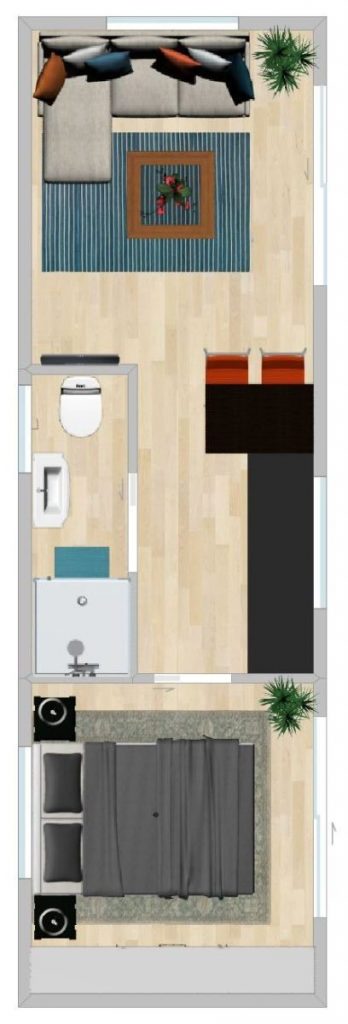
Visitor Industry Exostructure
26 March 2020 UNFORTUNATELY IT APPEARS THAT COVID-19 MAY HAVE DESTROYED THE VISITOR INDUSTRY FOR THE FORESEEABLE FUTURE. IF THE AIRLINES COLLAPSE AND THE COST OF FLYING TO NEW ZEALAND BECOMES TOO HIGH, THE INDUSTRY THAT EMPLOYS ONE-IN-EIGHT MAY BE WIPED OUT.
Not all mobile homes go to the hidden homeless. NZ is an outdoor country, with tramping trails, the new national cycle trails, wonderful seasides and glorious mountains. Visitors to NZ look for new experiences, not the same old drive from one motel to the next.
Pop-up mobile homes visitor villages offer a different, immersive and highly-social experience. After a day of cycling the rail-trail, instead of being bussed to the nearest town to be put up in a motel, the cycle guide and guests arrive at a pod village where each family has their own pod to sleep, and an outdoor campfire or a large marquee with a BBQ and picnic tables where conversation starts, laughter flows and friendships form.
Exostructure means the commons are outside. No corridors, lifts or lobbies, people put on clothes suitable for the weather and experience what makes New Zealand such a wonderful place to visit.
Support business innovation
What part of innovation and business does MBIE not understand? Why is it that MFE cannot understand that enabling people and communities to provide for their economic and social wellbeing means they need to be able to afford proper housing?
The most powerful tool the government has in its arsenal is the power of permission. Regulation is saying “no”. Permission is saying “yes”. Yes, with conditions, but said in a way that business knows they can do the job and stay in business.
At present, the mobile home industry is struggling to stay alive. Central and Local Government are viewed by the industry as blinkered and obstructionist.
It is essential that this mind-set changes.
MOBILE HOME v TINY HOME
Tiny Home on Wheels:
Below is a tiny home on wheels (THOW) being made in someone’s driveway. It is a one-off intended to be occupied by the maker. One presumes as the maker they will provide for their own health, safety, warmth, but this does depend on the maker’s skill. To be clear: these DIY units are not the concern of the Mobile Home Manufacturers Association.
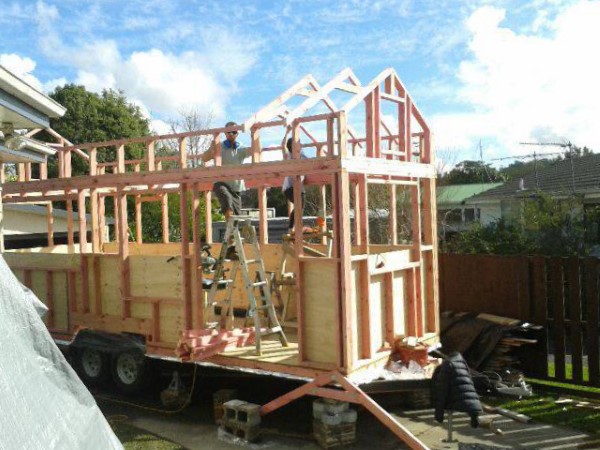
This is the same unit when complete and on site.

It is cute. It has a place in NZ. If it is fixed to land, it is a building. If not, as Judge Callaghan made clear in Dall v MBIE, it is a vehicle, not a building.
Mobile Home
Below are three mobile trailer homes manufactured in a factory at the same time. Sold or leased to the general public, they are identical except for features and options. They are supervised by quality-control managers responsible for ensuring they are safe, warm, healthy, durable and easy to exit in the event of a fire. They also are affordable. These particular 9×3 units cost about $70,000 or lease for $300.

This is a finished mobile trailer home made by the same company. This unit has one bedroom, lounge , kitchen & bath. It will also have a detached deck.
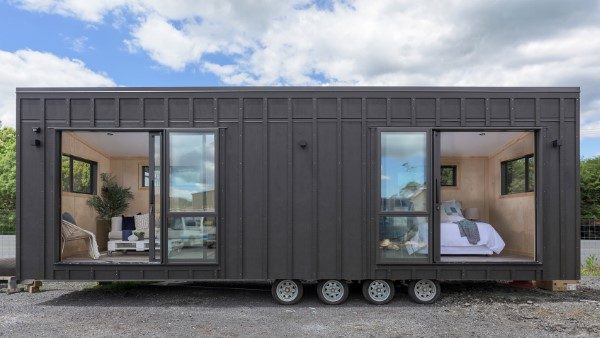
MORE ON DIY TINY HOMES
Tiny homes tend to be very creative, noting that this level of detail can cause costs to rise unless the maker is skilled and does not price their time.
Many are works of art, artisanal hand-crafted labours of love. In many cases they are on wheels parked they land through an informal right-to-occupy basis
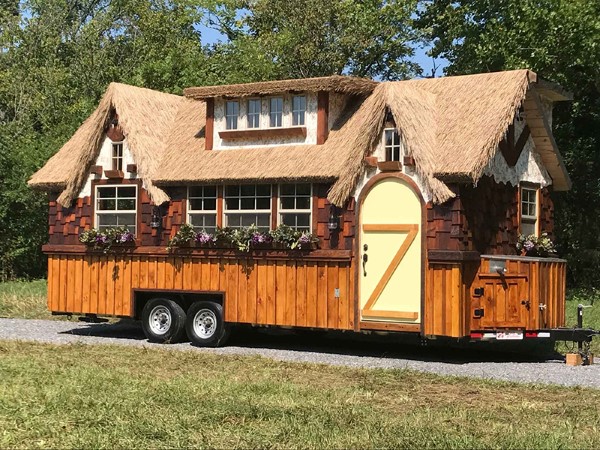
However, some are not works of art. While beauty is in the eye of the beholder, this tiny home was in Stuff’s recent “Neighbours rat out ‘ugly’ tiny homes“
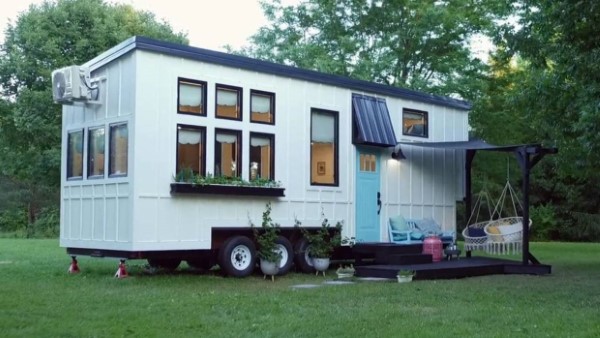
Ugly is not a criteria in either the RMA or Building Act, but it does spark conflict in “nice” neighbourhoods.
BRANDING CONFUSION
Some manufacturers of mobile trailer homes call their products tiny homes because the term has become popular. This is an example of a factory made mobile home branded as a tiny home:
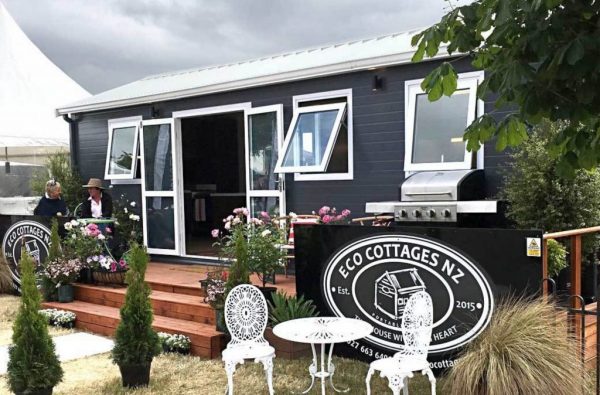
Note that while the unit looks like it is embedded in the land, this actually is at a trade show. The stairs are not fixed to land or the unit.
This is another factory built that looks like a DIY:
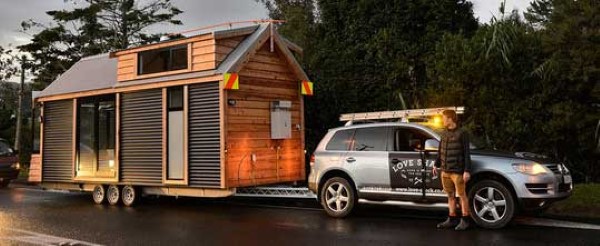
While they may call themselves tiny homes, they are factory-built… with a factory that turns out multiple units built to a quality standard, replicated every day.
